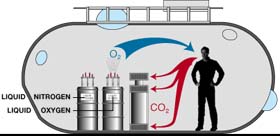 |

|

|

|
The technology The new capsule |
Contents |
The technology Power supply |

|
A PRESSURIZED CABINExperience has shown that the success of a round-the-world balloon flight requires a pressurized cabin. |

|
The weather conditions encountered during such a project require flying at a high altitude to take advantage of jet streams blowing at an average altitude of between 7,000 and 12,000 meters (23,000 ft and 39,000 ft), as well as the capacity to rise, if necessary, to 13,000 meters (43,000 ft) in order to travel through potential storm zones. This being so, the rarefaction of oxygen at these altitudes, the extreme cold (-56°C) and the atmospheric effects on the organism all represent factors which considerably reduce the chances of a successful round-the-world trip in a non-pressurized cabin. The principle of pressurization makes it possible to maintain atmospheric pressure in the cabin at a tolerable level, even at high altitudes. A pressurized capsule such as that of the Breitling Orbiter 3 makes it possible to obtain a level of comfort equivalent to travel on board a commercial plane. |
 |
The pressurization system on Breitling Orbiter 3 operates according to principles used on space missions. Once the capsule is hermetically sealed, the air is purified by a device which filters carbon dioxide gas (CO2) produced by the pilots, by means of lithium filters, while smells are absorbed by two active charcoal filters. The level of oxygen is constantly monitored by computer and regularly topped up by extra oxygen. If the percentage of CO2 rises above the set limit, an audible signal warns the crew, who can then proceed to a manual adjustment. |
 |
The temperature inside the capsule is maintained at a minimum of 15°C by a heat exchanger containing silicone fluid heated by burners or by means of two independent flames when the burners are not in operation. Should there be a leakage or if a window is opened, a nitrogen (N2) reserve is allows the crew to repressurize the cabin, an operation that may be repeated four times if necessary. In the cabin, the differential pressure is kept at 7.5 PSI. This means the pressure inside the capsule drops during the ascension, but not as fast as external pressure. On the graph, one may note that at an altitude of 10,000 meters (33,000 ft), for example, pressure in the cabin is equivalent to the atmospheric pressure encountered at an altitude of 2,200 meters (7,300 ft). |
![]()

|
The new capsule The technology |
Contents |
Power supply The technology |

|